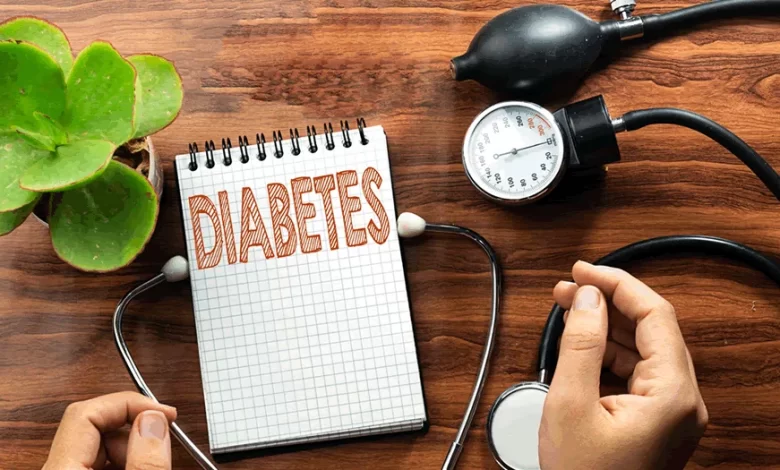
Diabetes is the disease caused by high blood sugar. You may have diabetes and not even know it. You can prevent and cure Type 2 Diabetes by taking action to control your blood sugar. It is strongly recommended that you lose weight, exercise, and stop smoking. You should eat less of the foods that elevate blood sugar levels, including sugar and simple carbohydrates. Here is smart information about how to prevent and cure Type 2 Diabetes.
What Is Diabetes, the Blood Sugar Disease
Diabetes is a higher than normal level of sugar in the blood. A healthy body digests food into sugars that enter the blood stream for energy and storage. In a healthy body, the pancreas produces insulin to regulate the level of sugar in the blood. Insulin is a hormone that is needed to convert sugar, starches and other foods into energy for daily life. Diabetes is the condition that occurs if the body cannot produce insulin, or the body cannot use insulin properly. When sugar levels in the blood remain high, you have diabetes. The blood sugar level is also called the blood glucose level. Diabetes cannot be cured, but it can be successfully managed and controlled.
What You Should Do to Prevent and Cure Diabetes, Type 2
Although there is no cure for diabetes, the disease can be controlled. All forms of diabetes have been treatable since insulin became available in 1921. In many people, Type 2 diabetes may be controlled with with lifestyle changes, exercise and diet. The doctor may also recommend medications . The objective is to keep the blood sugar level within the normal range. The symptoms of Type 2 diabetes often disappear if you follow a healthy diet low in carbohydrates, avoid foods which elevate the blood sugar, lose weight and get regular exercise. Don’t forget to get moving. Exercise is one of the best ways to help control diabetes. You will also want to control your blood pressure. When you stop smoking and lose weight, you also prevent and cure your diabetes.
The Diet to Prevent and Cure Diabetes, Type 2
A diet to control diabetes calls for vegetables, whole grains, meat, dairy and fruits, all eaten in moderation. The diabetes diet eliminates sugar, refined flour and processed foods. Processed meats like bacon, sausage, hot dogs should also be avoided. In fact, this diabetic diet is excellent for nutrition and weight loss, too.
There Are Three Types of Diabetes, Type 1, Type 2 and Gestational Diabetes
There are three types of diabetes. They are called Type 1 Diabetes, Type 2 Diabetes and Gestational Diabetes.
- Type 1 Diabetes results when the body cannot produce insulin. When the beta cells of the islets of Langerhans in the pancreas no longer can produce insulin, insulin deficiency results.Type 1 diabetes, usually diagnosed in children and young people, must be treated with insulin. It can also be called childhood-onset diabetes, juvenile diabetes, or insulin-dependent diabetes mellitus.
- Type 2 Diabetes results when the cells cannot use insulin properly. The cells are said to be insulin resistant and the level of insulin may also be low. It is the most common form of diabetes. Many cases of Type 2 diabetes can be controlled with diet and exercise. Type 2 diabetes is also called adult-onset diabetes, obesity-related diabetes, and non-insulin-dependent diabetes mellitus.
- Gestational Diabetes is when a pregnant woman experiences high blood sugar levels. It usually disappears after childbirth.
- Pre-diabetes is diagnosed when a person’s blood glucose levels are higher than normal but below the level for Type 2 diabetes.
The Symptoms of Diabetes Are Thirst, Hunger and Urination
Common symptoms of diabetes you might notice are increased thirst, increased fluid intake, increased hunger and more frequent urination. Diabetes can also cause mood swings, stress, blurred vision, fatigue, and eye, foot and skin problems. Often when Type 2 diabetes develops slowly over a number of years, a person does not even notice the changes.
The Home Test for Diabetes
If you have diabetes, your health professional will show you how to check your blood sugar level at home. Testing devices are practically pain free, The American Diabetes Association recommends that your blood sugar level be between 80 and 120 mg/dL before meals, and between 100 and 140 mg/dL at bedtime. Diet and exercise can help control your blood sugar levels. Some people will also require insulin. By following the advice of your doctor, you can defeat diabetes.
The People Who Are at Risk to Get Diabetes
The risk factors for diabetes are age, weight, smoking, high cholesterol, high blood pressure and ethnicity. You are more likely to get diabetes as you gain weight and grow older. Besides the obese and the elderly, diabetes is related to genetics and lifestyle factors. Diabetes is more likely to be a problem if you smoke, have high cholesterol, have high blood pressure and a sedentary lifestyle. Ethnicity is also a risk factor for diabetes. Diabetes is found more often among African Americans, Native Americans, Latinos, Asian Americans, and Native Hawaiians. It adds to your risk of diabetes if you are taking many prescription medications.
The Complications of Untreated Diabetes Are Serious
Untreated diabetes causes serious medical complications by destroying vital organs over time. This can ultimately lead to blindness, stroke, kidney disease, kidney failure, heart disease and nerve and blood vessel damage. Diabetes without proper treatment can cause many complications. Diabetes also causes hypoglycemia, diabetic ketoacidosis, and coma.
How Does Insulin Treat Diabetes
Insulin is a hormone produced by a healthy pancreas to regulate the sugar in the blood. Early research into the function of insulin and the use of injections of bovine insulin to treat diabetes was made by Banting and MacLeod at the University of Toronto, for which they received the Nobel Prize in Medicine in 1923. Human insulin to treat diabetes was just developed for commercial use in 1980 by the biotech company Genentech. Insulin can be taken orally or by injection.
The Diabetes Epidemic Is Spreading
Many people have heard about the disease called diabetes and the diabetes epidemic in the United States. Diabetes is increasing rapidly and has become an epidemic. In 2008 there were about 24 million people with diabetes in the United States alone. That is 8% of the population. 57 million additional people are estimated to have pre-diabetes. How astonishing it is to learn that 27% of the population is either diabetic or pre-diabetic. Diabetes is the seventh leading cause of death in the United States. Diabetes is becoming the epidemic of the 21st century.
